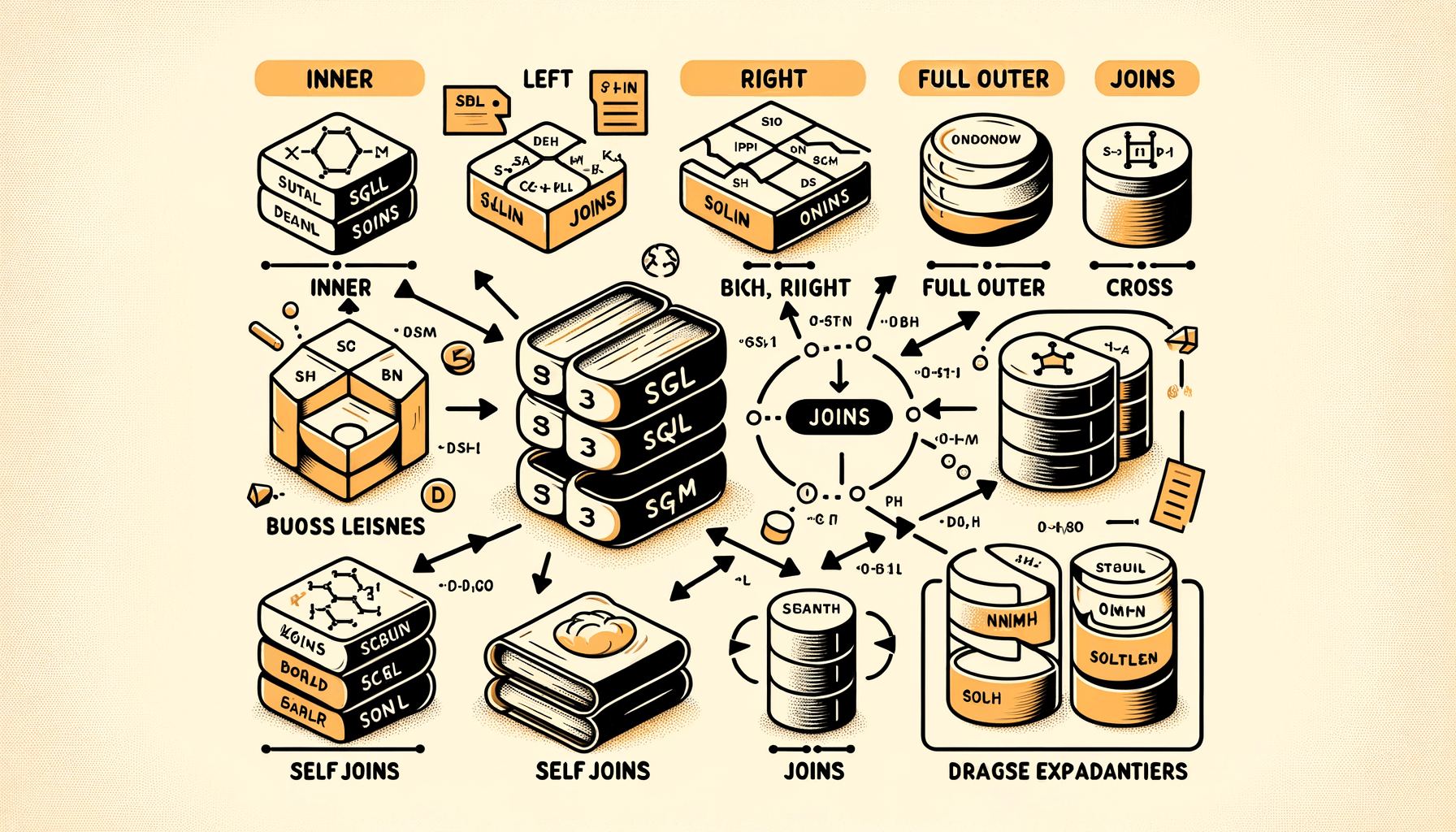A big variety of articles and resources

Mastering Database Querying: Tips and Techniques for Efficient Data Retrieval
 Sia Author and Instructor
Learn SQL
Sia Author and Instructor
Learn SQL
15 minute read
Mastering database querying is essential for anyone working with data. Whether you're a beginner or an experienced professional, understanding how to retrieve data efficiently can save you time and resources. This article will guide you through the basics and advanced techniques of SQL, helping you optimize your queries and improve your data management skills.
Key Takeaways
- Understanding SQL is crucial for managing and retrieving data from databases.
- Advanced SQL techniques like subqueries and joins can handle complex data retrieval tasks.
- Optimizing query performance involves strategies like indexing and analyzing query execution plans.
- Maintaining data integrity and consistency is key to reliable database operations.
- Good database schema design and management practices enhance data organization and retrieval.
Understanding the Fundamentals of Database Querying
The Role of SQL in Database Management
SQL, or Structured Query Language, is the backbone of database management. It allows us to interact with the database, retrieve data, and perform various operations. Mastering SQL is essential for anyone looking to work with databases effectively.
Basic SQL Syntax and Commands
To start with SQL, you need to understand its basic syntax and commands. Here are some of the most common ones:
- SELECT: Retrieves data from a database.
- INSERT: Adds new data to a table.
- UPDATE: Modifies existing data.
- DELETE: Removes data from a table.
These commands form the foundation of SQL querying and are crucial for any database operation.
Importance of Efficient Querying
Efficient querying is vital for optimal database performance. Poorly written queries can slow down your system and make data retrieval cumbersome. By focusing on writing efficient queries, you can ensure that your database runs smoothly and quickly.
Efficient querying is not just about speed; it's about making your database work smarter, not harder.
Understanding these fundamentals will set you on the right path to becoming proficient in database querying.
Advanced SQL Techniques for Complex Queries
Subqueries and Nested Queries
Subqueries, also known as inner queries, are used to perform operations that require multiple steps. They allow you to filter data in a more refined way. For example, you can use a subquery to find employees who earn more than the average salary in their department. Subqueries can be placed in various parts of a SQL statement, such as the SELECT, FROM, and WHERE clauses.
Using Joins for Data Integration
Joins are essential for combining data from multiple tables. There are different types of joins, including INNER JOIN, LEFT JOIN, and RIGHT JOIN. Each type serves a specific purpose. For instance, an INNER JOIN returns only the rows that have matching values in both tables. Joins are crucial for data integration and help in creating comprehensive datasets.
Window Functions for Advanced Data Analysis
Window functions perform calculations across a set of table rows related to the current row. Unlike aggregate functions, they do not group the result set into a single output row. This makes them ideal for running totals, moving averages, and ranking. Window functions enhance your ability to perform advanced data analysis without the need for complex subqueries.
Mastering these advanced SQL techniques can significantly improve your ability to handle complex data retrieval tasks, making you a more effective data analyst or database manager.
Optimizing Query Performance
Indexing Strategies
When it comes to speeding up your database queries, indexing is a key strategy. Indexes help the database find rows much faster than without them. However, it's important to choose the right columns to index. Generally, you should index columns that are frequently used in WHERE clauses or as join keys. But be cautious, as too many indexes can slow down write operations.
Query Execution Plans
Understanding how your database executes a query can provide insights into performance issues. By examining the query execution plan, you can see the steps the database takes to retrieve data. This can help you identify bottlenecks and optimize your queries. Tools like EXPLAIN in MySQL or PostgreSQL can be very useful for this purpose.
Avoiding Common Pitfalls
There are several common mistakes that can degrade query performance. For instance, using SELECT * can retrieve more data than necessary, slowing down your query. Instead, specify only the columns you need. Another pitfall is not using joins efficiently, which can lead to slow queries. Always aim to write queries that are both efficient and easy to read.
Optimizing query performance is not just about speed; it's about making your database work smarter, not harder.
Data Integrity and Consistency
Ensuring ACID Properties
When working with databases, it's crucial to ensure that transactions are processed reliably. This is where ACID properties come into play. ACID stands for Atomicity, Consistency, Isolation, and Durability. These properties guarantee that database transactions are processed in a reliable manner, even in the event of errors or failures. Atomicity ensures that all parts of a transaction are completed successfully, or none at all. Consistency ensures that a transaction brings the database from one valid state to another. Isolation ensures that transactions do not interfere with each other, and Durability ensures that once a transaction is committed, it remains so, even in the event of a system crash.
Implementing Constraints and Triggers
Constraints and triggers are essential tools for maintaining data integrity. Constraints are rules applied to database columns to ensure the accuracy and reliability of the data. Common types of constraints include primary keys, foreign keys, unique constraints, and check constraints. Triggers, on the other hand, are automated actions that are executed in response to certain events on a particular table or view. They can be used to enforce complex business rules, audit changes, and maintain data integrity across multiple tables.
Handling Transactions Effectively
Effective transaction management is key to maintaining data integrity. Transactions should be used to group multiple operations into a single, all-or-nothing unit of work. This ensures that either all operations are completed successfully, or none are. It's important to use transaction control commands like BEGIN, COMMIT, and ROLLBACK to manage transactions. Additionally, understanding the isolation levels and choosing the appropriate one for your application can help in avoiding issues like dirty reads, non-repeatable reads, and phantom reads.
Maintaining data integrity and consistency is not just about following best practices; it's about ensuring that your database remains reliable and trustworthy, even in the face of unexpected challenges.
Database Schema Design and Management
Normalization and Denormalization
Normalization is the process of organizing data to reduce redundancy and improve data integrity. It involves dividing large tables into smaller ones and defining relationships between them. Denormalization, on the other hand, is the process of combining tables to improve read performance, often at the cost of write performance. Striking a balance between normalization and denormalization is key to efficient database design.
Schema Evolution and Versioning
As applications evolve, so must their database schemas. Schema evolution involves making changes to the database structure without affecting the existing data or application functionality. Versioning helps track these changes over time, ensuring that updates are applied consistently across different environments. Using tools like Liquibase or Flyway can simplify this process.
Best Practices for Schema Design
- Use meaningful table and column names: Names should be descriptive and follow a consistent naming convention.
- Define primary keys: Ensure each table has a primary key to uniquely identify records.
- Use foreign keys: Establish relationships between tables to maintain data integrity.
- Indexing: Create indexes on columns that are frequently used in queries to speed up data retrieval.
- Avoid redundant data: Store data in one place to prevent inconsistencies.
A well-designed schema not only improves performance but also makes the database easier to maintain and scale. By following best practices, you can create a robust and efficient database structure that supports your application's needs.
Leveraging SQL for Data Analysis
Aggregating Data with Group By
When working with large datasets, it's crucial to summarize data efficiently. The GROUP BY clause in SQL allows you to aggregate data based on one or more columns. For instance, you can group sales data by region to see total sales per area. This technique is essential for generating reports and dashboards that provide actionable insights.
Using Analytical Functions
Analytical functions in SQL, such as RANK(), DENSE_RANK(), and ROW_NUMBER(), enable you to perform complex calculations over a set of rows. These functions are particularly useful for tasks like ranking employees based on performance or calculating running totals. Mastering these functions can significantly enhance your data analysis capabilities.
Building Complex Reports
Creating detailed reports often requires combining multiple SQL techniques. You might need to use subqueries, joins, and analytical functions together to extract and present data in a meaningful way. For example, a sales report might include total sales, average sales per region, and the top-performing products. By leveraging these techniques, you can build comprehensive reports that support data-driven decision-making.
In the realm of data analysis, SQL is an indispensable tool that transforms raw data into valuable insights. By mastering SQL, you can unlock the full potential of your data and drive better business outcomes.
Security Considerations in Database Querying
SQL Injection Prevention
One of the most critical aspects of database security is preventing SQL injection attacks. These attacks occur when malicious users insert harmful SQL code into your queries. To avoid this, always use parameterized queries and prepared statements. Never trust user input; always validate and sanitize it before using it in your SQL commands.
Role-Based Access Control
Implementing role-based access control (RBAC) is essential for managing who can access and modify data. By assigning specific roles to users, you can ensure that only authorized personnel can perform certain actions. This minimizes the risk of unauthorized data access and modifications.
Encrypting Sensitive Data
Encrypting sensitive data both at rest and in transit is crucial for protecting it from unauthorized access. Use strong encryption algorithms and ensure that encryption keys are stored securely. This adds an extra layer of security, making it much harder for attackers to access your data.
Ensuring the security of your database is not just about protecting data but also about maintaining the trust of your users and stakeholders.
Scalability and Performance Tuning
Horizontal and Vertical Scaling
Scaling your database can be done in two main ways: horizontal and vertical scaling. Horizontal scaling involves adding more machines to your database system, while vertical scaling means upgrading the existing machine's resources. Each method has its pros and cons. Horizontal scaling offers better fault tolerance but can be complex to implement. Vertical scaling is simpler but has a limit to how much you can upgrade a single machine.
Load Balancing Techniques
Load balancing is crucial for distributing database queries evenly across servers. This helps in preventing any single server from becoming a bottleneck. Techniques like round-robin, least connections, and IP hash are commonly used. Implementing effective load balancing can significantly improve your system's performance and reliability.
Monitoring and Profiling
To ensure your database performs optimally, continuous monitoring and profiling are essential. Tools like New Relic, SolarWinds, and Datadog can help you track performance metrics and identify bottlenecks. Regular monitoring allows you to make data-driven decisions to optimize your database.
Effective scalability and performance tuning are key to maintaining a robust and efficient database system. By understanding and implementing these techniques, you can ensure your database can handle increasing loads and maintain high performance.
Real-World Applications of Database Querying
Case Studies in Various Industries
Database querying is essential in many industries. For example, in e-commerce, it helps manage inventory and customer data. In healthcare, it supports patient record management and data analysis. Effective querying ensures that businesses can retrieve and use data efficiently.
Common Challenges and Solutions
One common challenge is dealing with large datasets. Using indexing strategies can help speed up queries. Another issue is ensuring data accuracy, which can be addressed by implementing constraints and triggers. Avoiding common pitfalls, like using SELECT *, is also crucial.
Future Trends in Database Querying
The future of database querying includes advancements in AI and machine learning. These technologies can optimize query performance and provide deeper insights. Additionally, the integration of SQL with other technologies will continue to grow, making data retrieval even more powerful.
Tools and Technologies for Efficient Querying
Popular SQL Databases
When it comes to SQL databases, there are several options to choose from. MySQL and PostgreSQL are among the most widely used. They offer robust features and are open-source, making them accessible for many users. SQL Server and Oracle are also popular, especially in enterprise environments.
Query Optimization Tools
To ensure your queries run efficiently, you can use various optimization tools. Tools like EXPLAIN in MySQL and PostgreSQL help you understand how your queries are executed. This insight allows you to make necessary adjustments for better performance. Additionally, tools like SQL Profiler for SQL Server provide detailed analysis of query performance.
Integrating SQL with Other Technologies
SQL doesn't operate in isolation. It often needs to be integrated with other technologies for comprehensive data management. For instance, integrating SQL with Python or R can enhance data analysis capabilities. Similarly, using SQL with web frameworks like Django or Flask can streamline web development processes.
Mastering these tools and technologies is crucial for efficient data retrieval and management. They not only improve performance but also ensure data integrity and consistency.
Best Practices for Writing Maintainable Queries
Code Readability and Documentation
When writing SQL queries, it's crucial to focus on code readability. Clear and well-structured queries are easier to understand and maintain. Use meaningful table and column names, and avoid abbreviations that might confuse others. Adding comments to explain complex parts of your query can also be very helpful.
Modular Query Design
Breaking down complex queries into smaller, reusable parts can make your SQL code more manageable. This approach, known as modular query design, allows you to test and debug each part separately. It also makes your queries more adaptable to changes.
Testing and Debugging Queries
Testing your queries is essential to ensure they return the correct results. Use sample data to verify the accuracy of your queries. Debugging tools can help identify and fix errors. Always test your queries in a development environment before running them in production.
Writing maintainable queries is not just about making your life easier; it's about ensuring that others can understand and work with your code in the future. This practice promotes collaboration and reduces the risk of errors.
Writing maintainable SQL queries is key to keeping your database efficient and easy to manage. By following best practices, you can ensure your queries are not only effective but also easy for others to understand and modify. Want to learn more? Visit our website for expert-led courses that will help you master SQL and advance your career.
Conclusion
Mastering database querying is a vital skill for anyone working with data. By understanding and applying the tips and techniques discussed, you can make your data retrieval processes more efficient and effective. Remember, practice is key. The more you work with SQL and other querying languages, the more proficient you will become. Keep exploring, keep learning, and you'll find that your ability to manage and analyze data will grow significantly. With these skills, you'll be well-equipped to tackle any data challenge that comes your way.
Frequently Asked Questions
What is SQL and why is it important?
SQL stands for Structured Query Language. It's used to communicate with and manipulate databases. Knowing SQL is crucial because it helps you manage and retrieve data efficiently.
What are the basic SQL commands I should know?
Some basic SQL commands include SELECT, INSERT, UPDATE, DELETE, and CREATE. These commands help you perform essential tasks like retrieving data and modifying database structures.
How do I optimize my SQL queries?
You can optimize SQL queries by using indexing, analyzing query execution plans, and avoiding common pitfalls like unnecessary columns in SELECT statements. Proper optimization can make your queries run faster.
What is a JOIN in SQL?
A JOIN clause is used to combine rows from two or more tables based on a related column. Different types of joins like INNER JOIN, LEFT JOIN, and RIGHT JOIN help you integrate data from multiple sources.
Why is data integrity important in databases?
Data integrity ensures that the data is accurate and consistent. It is essential for maintaining the reliability and trustworthiness of the database. Techniques like ACID properties and constraints help achieve this.
What are ACID properties?
ACID stands for Atomicity, Consistency, Isolation, and Durability. These properties ensure reliable processing of database transactions, making sure that all operations are completed correctly and consistently.
How can I prevent SQL injection attacks?
To prevent SQL injection attacks, use parameterized queries and prepared statements. These methods help ensure that user input is treated as data and not executable code, making your database more secure.
What is the difference between normalization and denormalization?
Normalization involves organizing data to reduce redundancy and improve data integrity. Denormalization is the process of combining tables to make data retrieval faster. Both techniques have their use cases depending on the specific needs of your database.







